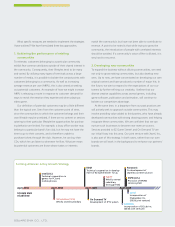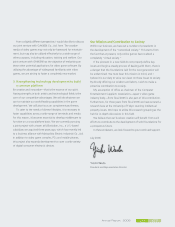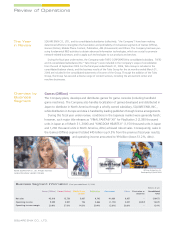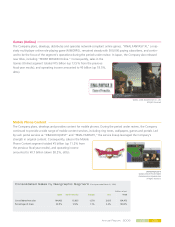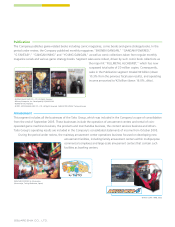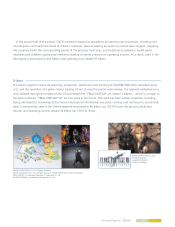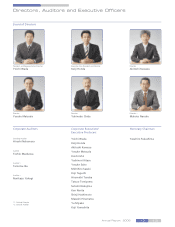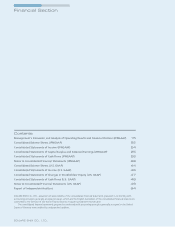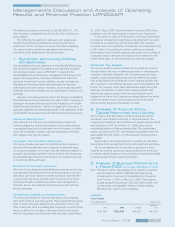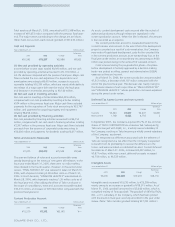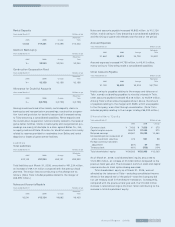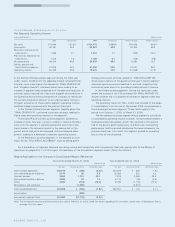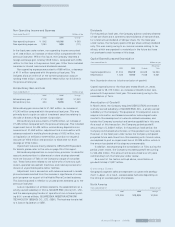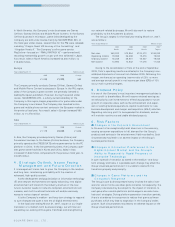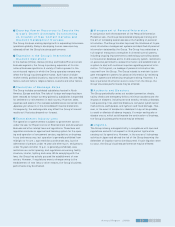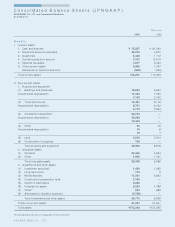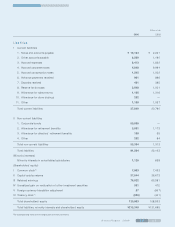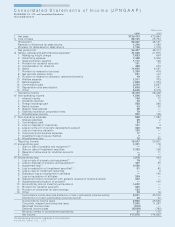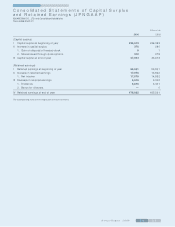Square Enix 2006 Annual Report Download - page 17
Download and view the complete annual report
Please find page 17 of the 2006 Square Enix annual report below. You can navigate through the pages in the report by either clicking on the pages listed below, or by using the keyword search tool below to find specific information within the annual report.
Management’s Discussion and Analysis of Operating
Results and Financial Position (JPNGAAP)
14 15
Annual Report 2006
The following is based on the views of SQUARE ENIX CO., LTD.
(the Company), management as of June 30, 2006, and has not
been audited.
The following management’s discussion and analysis also
contains forward-looking statements concerning the future
performance of the Company. For more information regarding
this, please read the disclaimer regarding forward-looking
statements at the beginning of this annual report.
1. Significant Accounting Policies
and Estimates
The consolidated financial statements of the SQUARE ENIX Group
(the Group) are prepared in accordance with generally accepted
accounting principles in Japan (JPNGAAP). In preparing the
consolidated financial statements, management shall choose and
apply accounting policies, and make estimates that affect the
disclosure of amounts in assets, liabilities, income and expenses.
Management formulated these estimates based on historical
performance and other factors. However, actual results may differ
materially from these estimates due to uncertainties inherent in the
estimates.
Important accounting policies used in the Group’s consolidated
financial statements are contained in the section titled “Summary of
Significant Accounting Policies Used in the Preparation of Consoli-
dated Financial Statements,” which is on page 28 of this report. In
particular, judgments for the estimates made in the preparation of the
consolidated financial statements are affected by accounting policies.
Revenue Recognition
Sales revenue of the Group is recognized when products are
ordinarily shipped or services are provided, while royalty revenue
is recognized based on the statement from the licensee. In certain
cases, the recognition of sales is decided according to contracts
with suppliers and type of products.
Provision for Doubtful Accounts
The Group provides a provision for doubtful accounts based on
estimated irrecoverable amounts to prepare for bad debt losses
on accounts receivable. In the event that the financial condition of
a supplier deteriorates and their solvency declines, the Group may
provide additional amounts to the provision for doubtful accounts
or record bad debts and losses.
Content Production Account
When the Group determines that differences between actual costs
and expected future demand for the content production account
and actual cash value, based on market conditions, have reached
a certain level, the Group will then perform a write-off. If future
demand and market conditions are worse than management’s
forecasts, there is the possibility that further write-offs will then
become necessary.
Unrealized Losses on Investments
The Group owns shares in financial institutions, and companies
with which it sells or purchases goods. These shareholdings include
stock in listed companies subject to price fluctuation risks in the
stock market and stock in privately held companies for which share
prices are difficult to calculate. In the event that the fair market
value of these shares as of the end of this fiscal year ended March
31, 2006 (“fiscal 2005”) have declined no less than 50% of their
acquisition cost, the entire amount is treated as an impairment.
In the event of a 30% to 50% decline, an amount determined
as necessary considering its significance and potential for recovery
is treated as an impairment. During fiscal 2005, the Company
recorded a loss from revaluation of investment securities amounting
to ¥91 million. A worsening in market conditions or unstable
performance at the invested company may require the recording of
revaluation losses in the event that losses are not reflected in the
current book value, or, the book value becomes irrecoverable.
Deferred Tax Assets
The Group records a valuation allowance to provide for amounts
thought likely to decrease in deferred tax assets. In evaluating the
necessity of valuation allowance, the Company examines future
taxable income and possible tax planning for deferred tax assets
with a high likelihood of realization. If the Company decides that
all or a portion of net deferred tax assets cannot be realized in the
future, the Company writes down deferred tax assets during the
fiscal year the decision is made. If the Company decides that
deferred tax assets in excess of the recorded amount can be
realized in the future, the Company recognizes deferred tax assets
to the recoverable amount and increases profits by the same
amount during the period the decision is made.
2. Analysis of Financial Policy,
Capital Resources and Liquidity
The Company internally finances working capital and capital
investment, and utilizes the issuance of corporate bonds. The
Company has issued yen-denominated zero-coupon warrant bonds
with maturity in 2010. As of March 31, 2006, there was no
outstanding balance of interest-bearing debt. The shareholders’
equity ratio stood at 56.7%. Cash and cash equivalents at end of
year totaled ¥75,252 million, a 7.4% decrease compared with a
year earlier.
Please refer to the details below for an analysis of cash flows
during fiscal 2005 and significant factors affecting those cash flows.
The Group believes that it is possible to procure the funds
required for working capital and capital investment in the future
to maintain growth based on its sound financial standing and ability
to generate cash through operating activities.
3. Analysis of Business Performance
in Fiscal 2005 (For the year ended March 31, 2006)
Note: The figures used in this analysis are for reference purposes
and are based on TAITO CORPORATION (Taito) being
included within the scope of consolidation for the period
from October 1, 2005, to March 31, 2006. These figures
include goodwill amounting to ¥27,232 million within non-
current assets, and payables related to merger totaling
¥66,999 million within current liabilities.
Assets
Total Assets
Years ended March 31 Millions of yen
Reference:
2005 2006 Change Taito
¥131,695 ¥213,348 ¥81,653 ¥91,335



